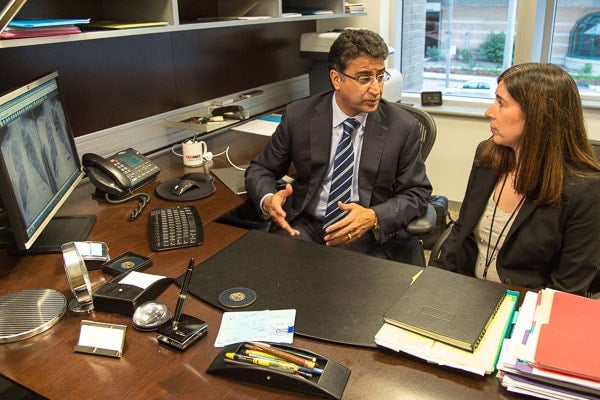
Making lung transplants less risky
Published: November 22, 2013
Shaf Keshavjee remembers the moment on November 7, 1983 when he heard the news: a group of University of Toronto doctors had performed the world’s first successful single lung transplant at Toronto General Hospital (TGH).
Still a medical student, Keshavjee was driving along Toronto’s Mount Pleasant bridge when the news was broadcast on the radio.
“Just the thought that a lung might need replacing was sort of novel to me at the time and the fact that they could do that,” he says. “I thought it was remarkable.”
Tom Hall, the first patient to survive the procedure, lived another six years after his surgery. His operation was the first in a series of lung transplantation milestones at TGH by members of U of T’s Faculty of Medicine.
The procedure breathed new life into a surgery that had failed 44 previous times in attempts made around the world. The realization of what was now possible inspired Keshavjee’s current work as director of the Toronto Lung Transplant Program, and Professor of Thoracic Surgery in U of T’s Department of Surgery.
Keshavjee scrubbed in as an intern when the world’s first double lung transplant was done at TGH in 1986. Later that same year, doctors at TGH performed the first pediatric lung transplant, and two years later, the first double lung transplant for cystic fibrosis was also achieved.
“I walked into a program by virtue of being a student at the University of Toronto,” says Keshavjee. “But it was the leading program in the world and it inspired me to be part of it, and to work to contribute and build it further. For the last 30 years, we’ve continued to be the leading program in lung transplantation.”
Keshavjee explains another Toronto milestone was reached in the early 1990s, when a solution known as LPD (low potassium dextran), was developed to make lungs safer, more stable and predictable. That was followed by a technique known as ex vivo lung perfusion, which was developed by Keshavjee and his team of researchers. It allows lungs to be removed from a donor, and genetically modified to better prepare them for transplant using a “personalized medicine” approach. The lungs can be examined, diagnosed, treated, and re-examined before they reach the recipient’s body. The process has already increased the number of donor lungs used.
“We now have the opportunity to improve lungs — make them work better than the way we found them — making a lung that looks more like you so that your body won’t reject it,” says Keshavjee.
“It’s just something that inspires people in our program every day — to know that this is where it all started and we all want to continue to push the limits, we all want to continue to transform the field,” says Lianne Singer, medical director of the Toronto Lung Transplant Program at University Health Network and associate professor of medicine at U of T.
Singer leads a group of respirologists who are involved in the medical aspects of transplantation. This includes caring for patients from the time of referral, and providing follow-up care for the rest of their lives. She explains that the procedure’s positive outcomes extend far beyond a patient’s ability to get off of oxygen.
“They’re able to get back to work, they’re able to look after their kids or their grandkids, they’re able to travel and take up sports or hobbies that they enjoy that they weren’t able to do before – so we hear that from patients and so we know that transplant’s having that impact,” says Singer, whose research interests include quantifying the improvements in quality of life experienced by patients who undergo these procedures.
The changes seen over the last 30 years are thanks to the hard work and innovation by a range of specialists.
“It’s not just an operation,” says Keshavjee. “It’s the research that leads to the innovations that we bring to the bedside, the breadth of the team – surgeons, respirologists, critical care doctors, anesthetists, nurses, perfusionists; it’s a complex program and a high performance team that’s able to pull off these remarkable achievements.”
Erin Howe is a writer with the Faculty of Medicine at the University of Toronto.


